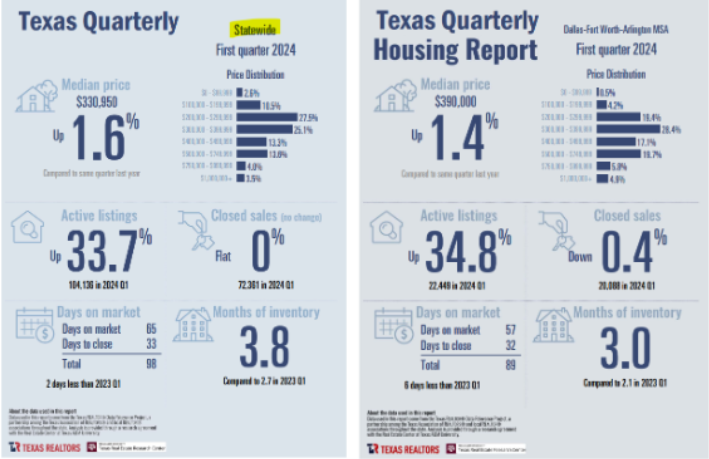
LANDLORD NEWSLETTER
June 2024

We all know the State of Texas is huge. Most don’t know about the TEX-A-PLEX. Do you? It will blow your mind!!!! The triangular region framed in by the cities of Austin, Dallas–Fort Worth, Houston, and San Antonio is experiencing a wave of growth of historic proportions more than anywhere in the world. ️ In 2020, the population of the Texas Triangle reached nearly 21 million. the Texas Triangle contains five of the 20 largest cities in the U.S., and was home to more than 70% of all Texans: City of Dallas, City of Fort Worth, City of Austin, City of Houston and City of San Antonio.

The Dallas Fort Worth International Airport (DFW) is bigger than all of Manhattan.
The University of Texas at Austin is the third largest landowner in the United States.
San Antonio is bigger than New York City and Detroit combined.
Houston has a bigger population than Colorado and 34 other states.
Four of the top ten metro statistical areas are in Texas.
The Texas economy is on fire. The state added 660,000 new jobs last year – more jobs than any other, and twice the number of new jobs compared to its historical average. With Dallas by far leading the growth. 50,000 jobs a month, that’s almost 2,000 jobs a day every day of the week for an entire year.
No state income tax
The Tex-a-plex is home to over 50 Fortune 500 companies. And has more Fortune 1000 companies than any other state.
At 2.4 TRILLION, Texas is ranked as the 9th largest economy among nations of the world by GDP, ahead of Canada, South Korea, Russia, and Australia.
Texas is the largest exporter of goods in the United States Dallas is home to the fourth most BILLIONAIRES in the world.
Houston has more than 5,000 energy related firms and is the energy capital of the world.
The Texas Medical Center is the largest in the world located in Houston.
25% of ALL retail space in the United States is in Texas.
Austin is the live music capital of the world. South By Southwest Austin City Limits Live at The Moody Theater (ACL Live)
There are 12 professional sports teams in the Tex-A-Plex.
You can further your education in the great state of Texas at any one of the 159 universities and colleges in order to prepare yourself for a successful and prosperous career. Including 6 medical schools.
Texas A&M University has an enrollment of 74,829 the largest student body in the United States
DFW leads nation in population growth
DALLAS-FORT WORTH-ARLINGTON (Dallas Morning News) – The DFW area led the nation in population growth last year, according to latest U.S. Census Bureau data.
In 2023, the Metroplex added 152,598 residents for a total of 8.1 million. Houston had the second largest amount of growth with 139,789 residents, bringing its total to 7.5 million. The next largest was Atlanta with 68,585 (total of 6.3 million). Austin and San Antonio ranked seventh and ninth with growth of 50,105 (to almost 2.5 million) and 48,071 (to 2.7 million), respectively.
Eight of the top ten U.S. counties for population growth were Texas counties, with Harris County being first (53,788), Collin County second (36,364), and Montgomery County third (31,800).
Texas and Florida Sellers Cutting Prices
While home sales and prices are fluctuating across the nation, two southern states—Texas and Florida — are showing signs of becoming genuine buyers' markets. New data shows that housing supply is surging in these two states, and sellers are responding by cutting their asking prices.
One reason: a surge in homebuilding in both states which was fueled by mass migrations during the pandemic era. In addition, out-of-town buyers who originally planned to head to Florida ended up buying in nearby North Carolina and Tennessee, where home prices are lower.
One Dallas, Texas agent described 2023 as her slowest market in 20 years, with many would-be sellers holding on to their low-interest mortgages. More recently, the numbers of homes for sale in Dallas grew 20% when compared to March 2023.
Of the 10 metro areas where sellers are most likely to negotiate prices, half are in Florida. North Port-Sarasota came in first with 48% of listings lowering their prices in March. More Florida cities followed, with Tampa seeing 44% of listings cutting prices and 41% of Cape Coral homes following suit. Texas metros Houston and San Antonio both saw 33% of listings reduce their original prices.1
Texas squatting laws under review
AUSTIN (Yahoo News) – State senators met this week to consider possible changes to the state’s laws regarding squatters. In Texas law, squatting falls through the policy cracks between criminal trespass and an eviction proceeding.
Senators will consider adding increased penalties for squatting, making the act more comparable to criminal trespassing, which would remove the large hurdle of squatting being viewed as a civil matter by the judiciary.
Outside of increasing penalties, senators discussed avenues to ensure law enforcement officers have a way to positively identify who owns or resides in a home in question, identifying documentation requirements for proving residency, having oversight of judicial and police responses in the future, and creating a mechanism for homeowners to initiate a removal of a squatter despite protests.
The committee intends to move quickly once the legislative session begins in January.
Other states, including Louisiana, Alabama, and West Virginia, have recently implemented squatting laws.
2024 Texas Real Estate Forecast

Given the Lone Star State’s powerful economic influence, real estate decision makers shape our entire economy and impact more than 30 million residents. Our forecast shines new light.
Texas is a real estate trendsetter when it comes to residential, commercial, and land markets in the U.S. In fact, four Texas housing markets—DFW, Houston, Austin, and San Antonio—outranked every U.S. real estate market in 2023. Is this sustainable in 2024? That’s where our 2024 Texas Real Estate Forecast illuminates with relevant and reliable data.
Not all real estate decisions are good ones, but an informed economic forecast can improve the odds. Our new forecast is intended to help Texans make better real estate decisions.
It draws attention to the most influential, big-picture trends that impact individual real estate asset markets (see the macro drivers sidebar).
It gives our best consensus projections for those markets.
And it connects the dots between the macro drivers and risk projections for contingency planning across the state (see the seven principles).
To help shape this forecast, our research team adopted seven principles:
AUDIENCE. Real estate decision makers are the audience: financiers, developers, builders, homebuyers and sellers, business occupiers, and those who facilitate real estate transactions.
ASSETS. For residential housing, we include single-family and multifamily housing; for commercial spaces, we include office, industrial, and retail; and for land, we consider rural land.
COMPARISON. We present 2024 results qualitatively and in comparison to 2023’s overall performance.
METHOD. We use both quantitative and qualitative methods for team consensus.
SCENARIOS. We base real estate asset forecasts on plausible scenarios.
EVALUATION. We will regularly evaluate the forecast and revise as needed.
VETTING. We questioned and challenged each other’s methods and results before reaching a consensus on macro driver assumptions and asset forecasts. We enlisted outside authorities to challenge assumptions and forecasts for efficacy.
The 2024 Texas Real Estate Forecast: It’s REAL ESTATE. It’s RELEVANT. It’s TEXAS.
Key Macro Drivers
The market behaviors and established macro drivers are the foundation of TRERC’s asset forecasts in 2024. Our economists and researchers believe the macro drivers listed here were the most important determining factors in this forecast. Each market—residential, commercial, and land—includes a row of icons indicating which macro drivers will most impact that market asset.

Single-Family Housing
2023 Situation: There are 8.2 million single-family homes in Texas. Single-family home sales continued to plummet with final sale levels likely to fall somewhere between 320,000 and 340,000. Median home price ranged between $320,000 and $345,000 and should end the year below $340,000. Statewide single-family rents ended the year at $2,100 per month.
Deliveries - Single-family deliveries will increase in 2024 relative to 2023. With almost 4 percent growth over last year, construction will match pre-COVID levels.
Prices - At best, average overall home price levels could remain flat or, at most, dip slightly but stay near $340,000.
Rent - Single-family rents are expected to fall, continuing their 2023 trend.
Sales - Home sales have not bottomed out, and total sales are expected to remain flat in 2024 compared to 2023, at about 330,000 units. Lower interest rates for at least part of 2024 may boost this somewhat. New sales will continue to account for a larger-than-average share of total sales—around 20 percent.
Wall Street Has Spent Billions Buying Homes. A Crackdown Is Looming.
Lawmakers say investors that scooped up hundreds of thousands of houses to rent out are driving up home prices
Wall Street went on a home-buying spree. Now, more lawmakers want to stop it from ever happening again.
Democrats in the U.S. Senate and House have sponsored legislation that would force large owners of single-family homes to sell houses to family buyers. A Republican’s bill in the Ohio state legislature aims to drive out institutional owners through heavy taxation.
Lawmakers in Nebraska, California, New York, Minnesota and North Carolina are among those proposing similar laws.
While homeowner associations for years have sought to stop investors from buying and renting out houses in their neighborhoods, the legislative proposals represent a new effort by elected officials to regulate Wall Street’s appetite for single-family homes.
These lawmakers say that investors that have scooped up hundreds of thousands of houses to rent out are contributing to the dearth of homes for sale and driving up home prices. They argue that investor buying has made it harder for first-time buyers to compete with Wall Street-backed investment firms and their all-cash offers.

Investors of all sizes spent billions of dollars buying homes during the pandemic. At the 2022 peak, they bought more than one in every four single-family homes sold, though more recently their activity has slowed as interest rates rose and supply became tighter. Two of the largest home-buying firms, Invitation Homes and AMH, are publicly traded companies, while a number of other companies, backed by private equity, hold portfolios of tens of thousands of homes nationwide.
Companies that buy single-family homes say their businesses provide renters the opportunity to live in desirable neighborhoods where they otherwise couldn’t afford to buy.
With home prices and rents near record highs around the U.S., legislators and officials at all levels of government have become more active on housing issues. States have passed new measures to fund more affordable housing, to allow builders to bypass local zoning laws and to make the eviction process more favorable to tenants.
Most calls to block large companies from snapping up homes come from liberals, but some conservatives also show an inclination to crack down.
This “corporate large-scale buying of residential homes seems to be distorting the market and making it harder for the average Texan to purchase a home,” Republican Gov. Greg Abbott wrote on X last month. “This must be added to the legislative agenda to protect Texas families.”
Close to equal numbers of voting-age Republicans and Democrats said they would support a measure to block Wall Street firms from buying homes, according to a new study funded by the University of California, Santa Barbara, and the Manhattan Institute, a conservative think tank. The study gauged opinion from 5,000 renters and homeowners in urban and suburban ZIP Codes.
Proposals to curb investors might be popular with voters, but so far they haven’t gained much traction in legislatures. None of the bills in Congress or in any of the state houses has reached a floor vote.
Advocates for the single-family rental industry, such as the National Rental Home Council, oppose such legislation and blame rising prices on an undersupply of new-construction homes. They also point to the relatively low number of homes owned by institutional investors, defined as those companies with portfolios of 1,000 homes or more. Some research estimates these companies own 3% to 5% of American rental homes.
In some American cities, institutional investors hold a much larger share of homes than they hold nationally. In Atlanta, nearly 11% of all rental homes in the five-county area are now owned by three real-estate companies, a recent study by researchers at Georgia State University found. A 2022 analysis by the U.S. Department of Housing and Urban Development said 21% of Atlanta rental homes were owned by some large institution.
Rep. Nikema Williams (D., Ga.), from the Atlanta area, in December co-sponsored the End Hedge Fund Control of American Homes Act in the U.S. House. The act “won’t solve all of the problems, but it will definitely make an impact,” she said in an interview.
Critics of regulation note that many of the largest investors have bought very few or no homes in the past year. “The great trade is done,” said John Burns, founder of the eponymous housing research and consulting firm. “So what are you trying to stop?”
Smaller investors that own between 10 and 99 homes have stepped up their share of home buying this year, Burns said. Some of the proposed legislation would also target these smaller investors.
The bills in the House and Senate would cap rental-home ownership at no more than 50 homes for many companies, requiring them to sell off any more they already own. A bill in Minnesota, meanwhile, would limit ownership to 20 homes.
Bills to block landlords in the Ohio and Nebraska state legislatures were written in response to a small number of investors buying up hundreds of homes in a handful of Cincinnati and Omaha neighborhoods.
Louis Blessing III, a Republican representing suburbs of Cincinnati in the Ohio Senate, introduced a bill to tax large landlords so heavily that they would likely feel compelled to sell their properties. Blessing said he is concerned about real-estate companies developing monopoly power in some neighborhoods, while putting starter homes further out of reach for home buyers.
“It’s an antitrust in spirit bill,” he said. Write to Will Parker at will.parker@wsj.com



Please bear in mind 3G Properties Group handles basic maintenance requests
and is not a general contractor or construction company. We are happy to work
with YOUR preferred vendors as long as 3G obtains proof of their liability
insurance, copy of their W9 and coordinates the repairs. As your property
management company, we are charged with coordinating all maintenance with
your resident as part of our liability protection for both you and 3G. If the owner,
resident and vendor are communicating outside of our Maintenance Coordinator
and/or 3G team, this can cause significant problems. We expect to pay your
vendor through our system so all of your annual expenses are reflected on your
1099. 3G Properties Group strives to provide you with a “hands off” experience
as much as possible, relieving you from maintenance burdens and headaches!

Notes from a few of our residents and other landlords!
- I recently started working with 3G Properties Group as a new property investor, and I couldn't be happier with their services. They helped me rent out my place seamlessly and professionally. The team is incredibly thorough, ensuring every detail is covered, which gave me great peace of mind. Their response time is excellent; they always get back to me promptly. I want to give a special shout-out to Michelle for their quick responses and helpfulness with all my questions. Their support has been invaluable in navigating the rental process. Highly recommend 3G Properties Group!
Kien P
- My experience with 3G, has been top tier!!! We have been tenants for 5 years, and counting. We have received nothing but great service! The initial process was very smooth, the maintenance crew is phenomenal and everyone in the office is attentive and quick to respond. We love being a part of 3G! Stefani W
- At a devastating time in my life 3G properties took all of the responsibility for my house. I trust them implicitly. JR

Happy Father’s Day
June 16th
Not sure what to do for Father's Day 2024? From throwing your dad a pizza party at home, making a Father's Day craft, or writing a sweet Father's Day quote in a Father's Day DIY card, there are plenty of creative things to do for Father's Day that you can pull off.
Ideas for Father's Day
Spoil him with breakfast in bed
Breakfast in bed isn't just for Mother's Day! Dads can enjoy it too! Whip up some of his favorite brunch treats and start Father's Day off right.

Breakfast Meatballs
INGREDIENTS
Cooking spray
4 slices thick-cut bacon (about 5 ounces)
1 medium Pink Lady or Granny Smith apple
1/2 medium yellow onion
1 large egg
1/2 cup shredded sharp cheddar cheese (2 ounces)
1/2 medium bunch fresh chives
1 1/2 teaspoons kosher salt
1/2 teaspoon freshly ground black pepper
1/2 cup fine, dry breadcrumbs
1/2 cup whole or 2% milk
1 pound uncooked breakfast sausage
2 tablespoons maple syrup, plus more for drizzling
Serving suggestions: creamy polenta, cheesy grits, or buttered noodles
INSTRUCTIONS
Arrange a rack in the middle of the oven and a second rack in the upper third. Heat the oven to 400°F. Coat a rimmed baking sheet with cooking spray.
Prepare the following, adding each to the bowl of a food processor fitted with the blade attachment as you complete it: Cut 4 thick-cut bacon slices crosswise into thirds. Core and chop 1 medium Pink Lady or Granny Smith apple (no need to peel). Chop 1/2 medium yellow onion into large pieces. Pulse until finely chopped, about 15 (1-second) pulses.
Whisk 1 large egg in a large bowl until broken up. Finely chop 1/2 medium bunch fresh chives until you have about 1/4 cup and add to the bowl. Add 1/2 cup shredded sharp cheddar cheese, 1 1/2 teaspoons kosher salt, 1/2 teaspoon black pepper, and whisk to combine.
Place 1/2 cup fine, dry breadcrumbs and 1/2 cup whole or 2% milk in a small bowl and stir to combine. Remove the casings from 1 pound uncooked breakfast sausage if needed. Add the sausage to the egg mixture and use your hands to thoroughly combine. Add the bacon mixture, soaked breadcrumbs, and 2 tablespoons maple syrup. Mix them thoroughly into the meat with your hands.
Form the mixture in 1 1/2-inch meatballs (about 2 tablespoons each), rolling each between damp hands until mostly smooth. Place on the baking sheet so that they are not touching.
Roast on the middle rack until the meatballs are cooked through, lightly browned and they register at least 165°F in the center on an instant-read thermometer, 25 to 30 minutes. Turn the oven to broil on high. Transfer the baking sheet to the upper rack and broil until golden brown, about 2 minutes. Drizzle with more maple syrup and serve immediately.
RECIPE NOTES
Make ahead: The meatballs can be shaped and refrigerated up to 1 day ahead. Arrange them in a casserole dish or on a baking sheet, but don't squish them together, and cover before refrigerating.
Storage: Refrigerate leftover meatballs in an airtight container for up to 5 days. Reheat over low heat in a saucepan or in the microwave.



